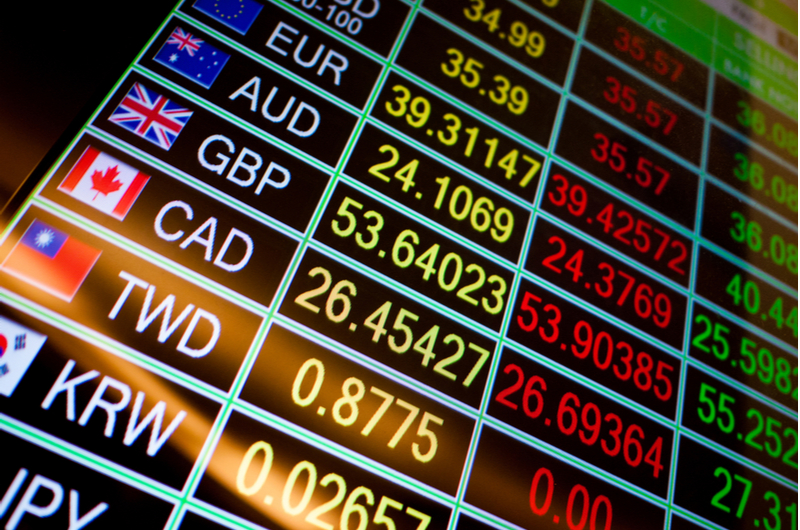The foreign exchange rate is a trading style based on converting one currency to another. It is commonly referred to as forex. Whenever you trade in the forex market, you are selling one currency in exchange for another. The market uses a three-letter code to designate the currency. The first code in a pair is the base currency, which is what you are trading. The second is the quote currency, which is what you receive in exchange for the base currency. For example, American currency is represented by USD, while Japanese yen is denoted by JPY. If you wanted to exchange yen for dollars, you would look for USD/JPY pairings on the forex market.
The goal of forex trading is to exchange one currency for a more valuable one. This requires following market trends to predict when a currency is expected to go up in value. If you correctly predict an exchange, you end up trading when the rates are lower, then profit once the currency rates officially change. Unlike stocks or other investments, forex trading is available 24 hours a day. This is because the worldwide nature of forex trading means there’s no centralized marketplace.
Types of Forex Pairs
While there are many currencies in the world, only a handful are traded on the forex market. There are four pairs of currency exchanges, major, minor exotic and regional. Major pairs make up nearly 80 percent of all forex trades. These include EUR/USD, USD/JPY, GBP/USD and USD/CHF.
Minor pairs are less traded, but still feature the major currencies, with the exception of the USD. A pairing like EUR/GBP or GBP/JPY is an example of a minor pair. Exotic pairs feature a major currency and a lesser-known economy, such as USD/PLN or EUR/CZK. Regional pairs refer to broader exchanges classified by a region instead of a primary currency.
How Forex Trading Works
Unlike other investment training, all exchanges take place over the counter market. This means there is no centralized exchange, like the stock market. Instead, forex trading is overseen by a global network of banks and similar financial institutions. The largest marketplaces for forex trading are located in New York, London, Sydney and Tokyo.
Today, most forex trades take place over an app. Apps allow you to immediately transfer funds while also getting the latest information on currency changes. Both of these are instrumental if you want to succeed at trading currencies. There are a few different marketplaces for forex apps.
The first is spot forex market. This is the most direct form of currency trading. All of the trades are done in real time, based on the current values of the currency at the time of the trade. Forward marketing is a contract to buy or sell a set amount of currency at a specified time. More complex contracts may have multiple trade dates. The trade must take place, no matter the value of the currency.
The last type of market is futures. Futures also use a contract, but a predetermined price is used for the exchange. This price does not change based on the current value of the currency.
Getting Started in Forex Trading
Because Forex is a complicated market, the first step to successfully trading is doing research. You must understand how currency is valued and when changes are expected to occur. Part of the complexity of Forex trading is you must know multiple currencies. Do not worry about learning all the currencies at first. Begin with a few currencies, focusing on the major pairs. Several apps include demo accounts. These let you practice simulated trades. While they are not direct examples of how the forex market works, it is a good way to get familiar with the process, as well as learning how to use your app.
Trading in the Forex market typically requires less capital than other markets. The exact amount may vary depending on the app you use, but in most cases, you can start investing with as little as $100.
FXTM
FXTM is a respected financial management platform, with trading options for both novice and veteran forex traders. The app includes links to helpful resources to help you track currency changes and learn what to look for in the market. The flexible leverage option allows you to limit trades based on your current earning potential. It also evaluates the risk of certain trades, limiting your selection to easier options. As you increase your earnings, you start to see riskier trading options. While this learning system is not perfect, most users give it a positive review. It also comes with an intuitive demo account, with several tutorials for new traders.
Trade Interceptor
Trade Interceptor is a forex app available for iPhone and Android devices. Unlike other options, there aren’t any tutorials or extra features for beginners. What makes it a popular app is the number of trackers available by default. Trade Interceptor also includes lesser viewed currency. The app was also one of the first to start tracking Bitcoin and other crypto currencies. Trade Interceptor has several alert options, letting you immediately jump on trades when currency changes. You can also set alerts for general news updates.
Stock Trainer
Stock Trainer is largely aimed at new forex traders, but there are useful features for veterans as well. One downside of the app is it is only available on Android as of writing. One of the useful features is the ability to look at previous currency changes, dating back to 10 years. This is helpful for new traders who want a comprehensive history on previous investments. There are also articles highlighting what trades previous users made, as well as a breakdown on why those trades worked. It is one of the best choices to build up your forex portfolio, but as you become more comfortable, you may want to switch to a more advanced app.